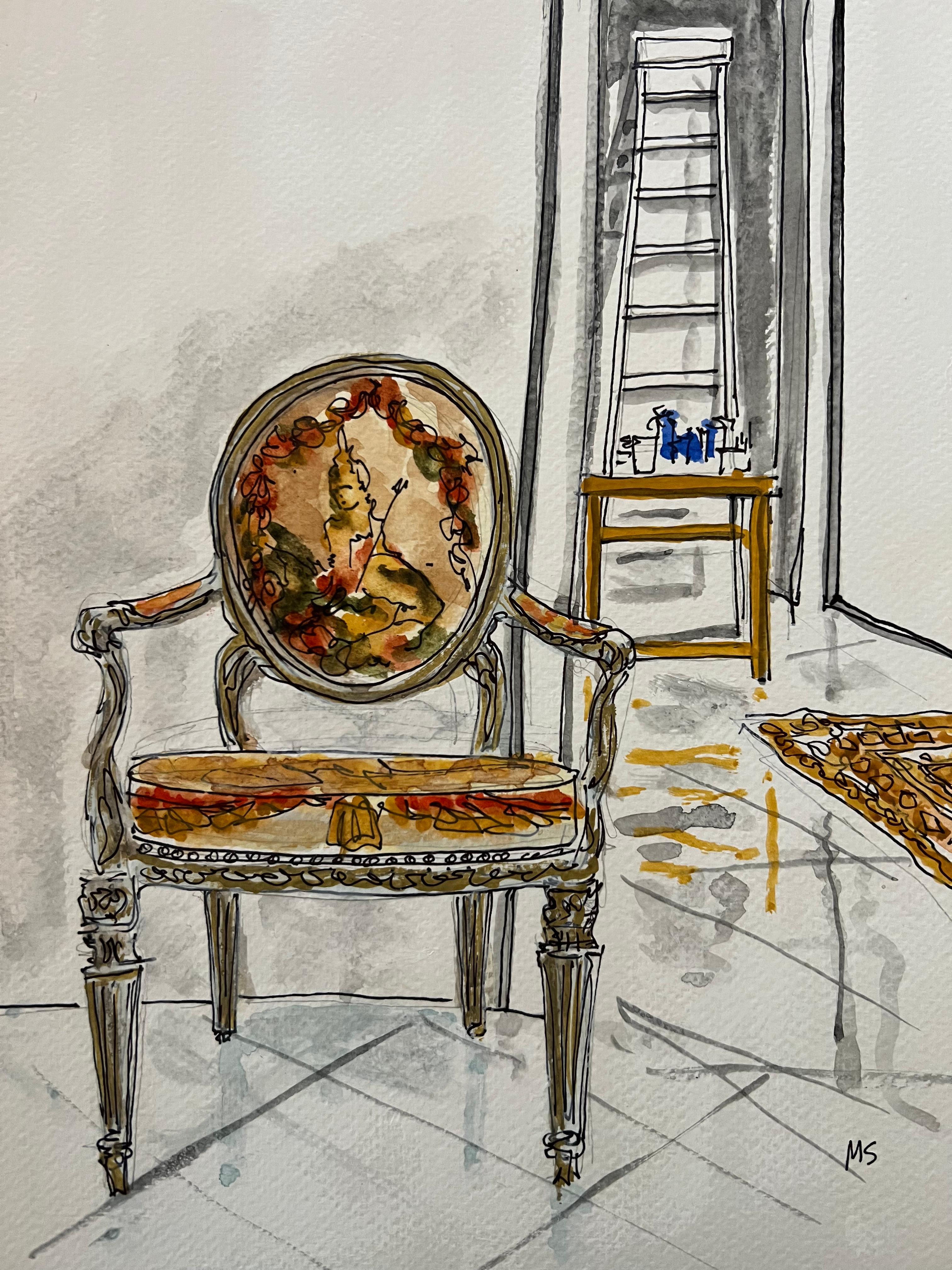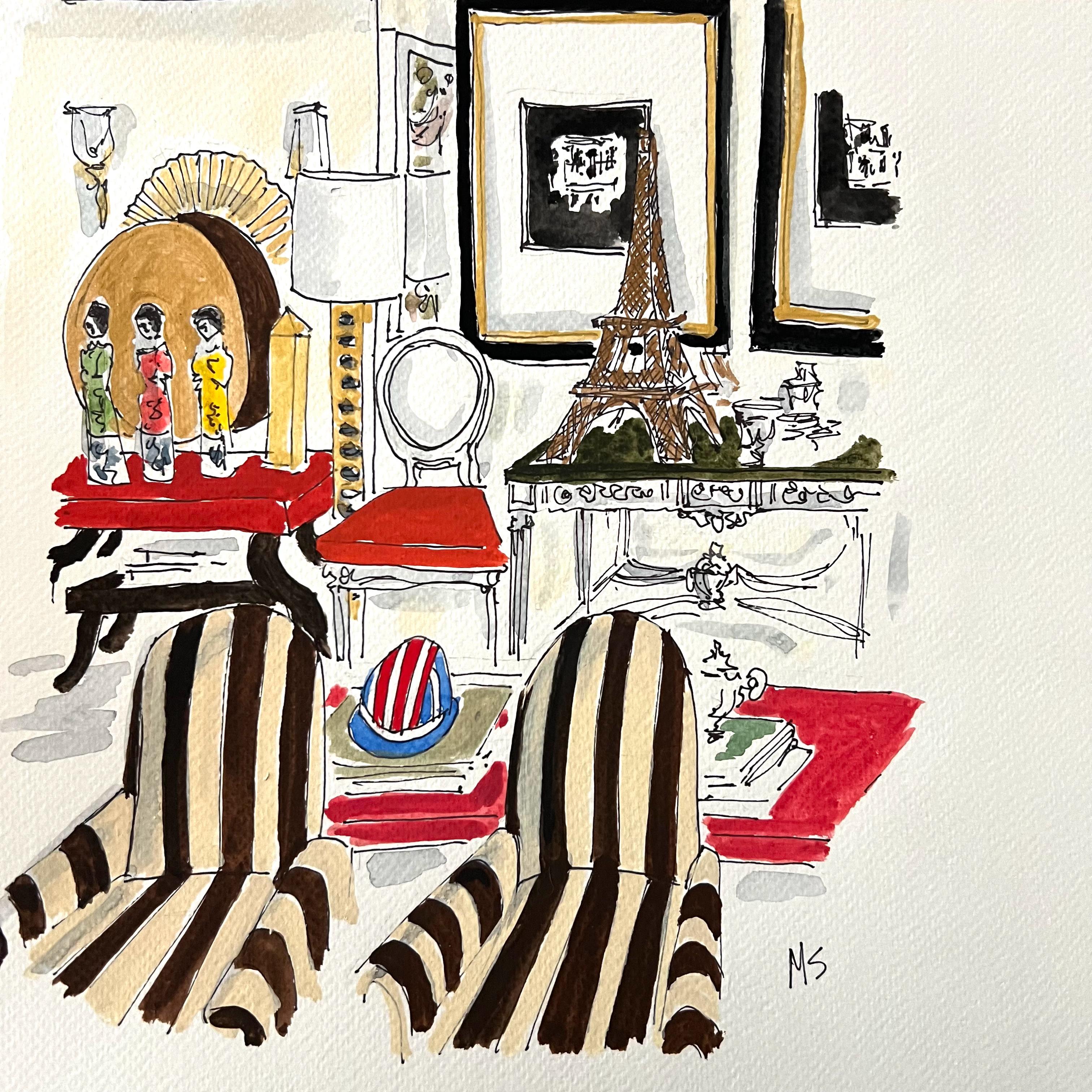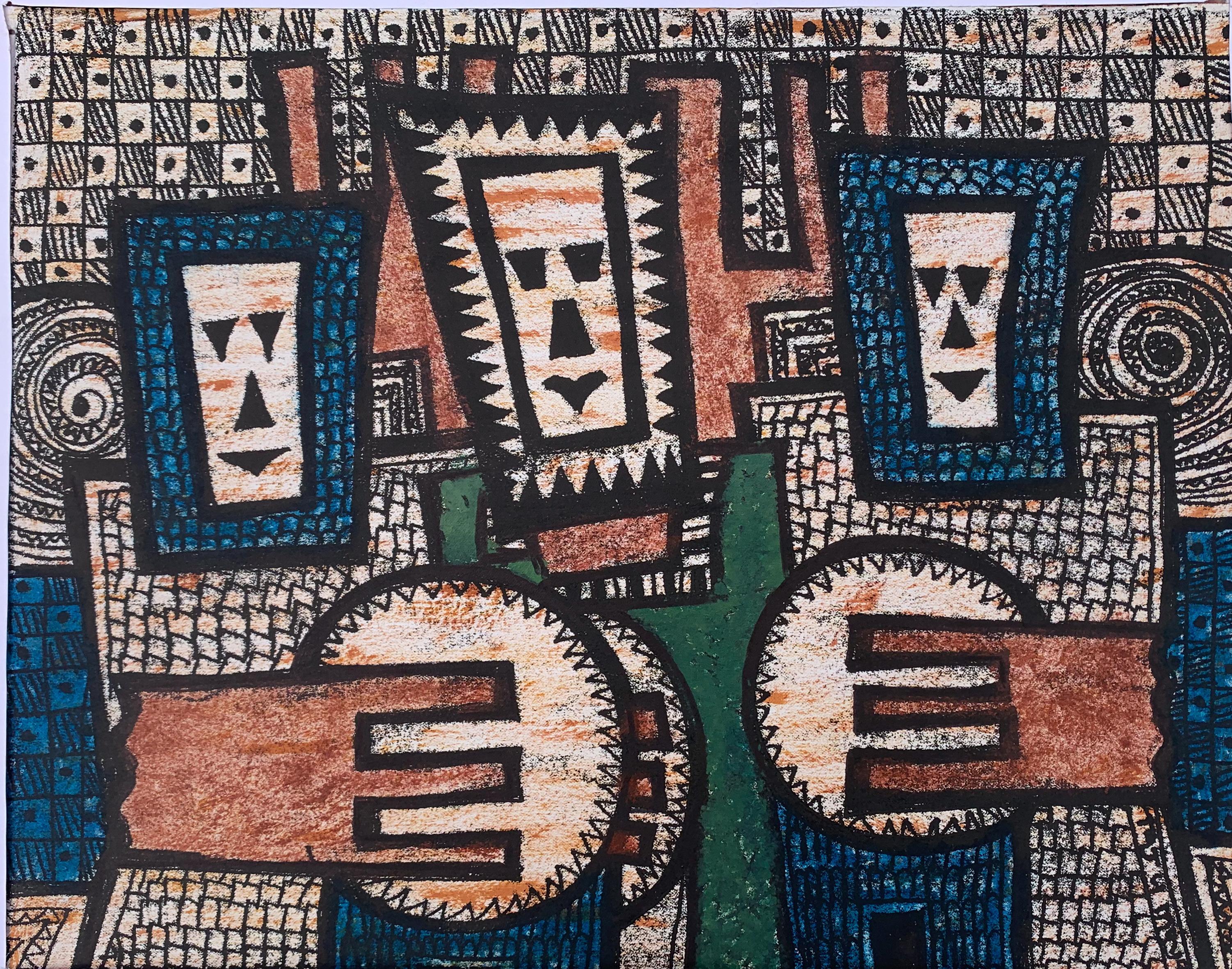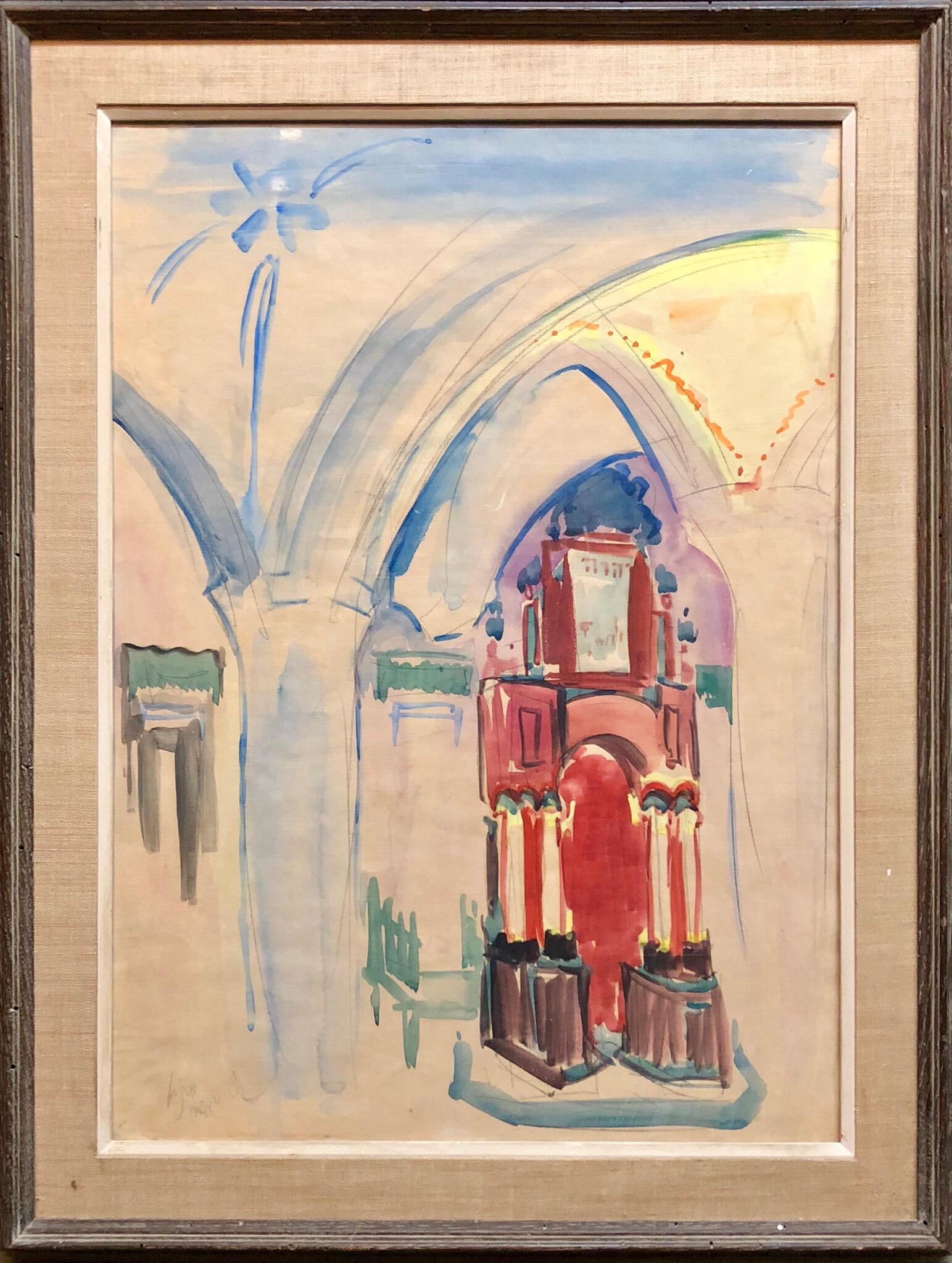Items Similar to Baroque Interior, a drawing attributed to Francesco Battaglioli (1725 - 1796)
Want more images or videos?
Request additional images or videos from the seller
1 of 6
Baroque Interior, a drawing attributed to Francesco Battaglioli (1725 - 1796)
About the Item
The technique of this luminous architectural drawing with its rigorous perspective is perfectly representative of the creations of the Venetian school’s 18th century vedutists. Similar drawings support its attribution to Francesco Battaglioli.
Iron gall ink and grey ink wash on paper
13 3/8 “ x 8 7/8 “ (34 x 22.5 cm)
We wish to thank Mrs Bożena Anna Kowalczyk who suggested the attribution to Francesco Battaglioli based on a photograph of the artwork.
1. Francesco Battaglioli
Little is known about the life of Francesco Battaglioli. Born in Modena in 1725, where he probably did his apprenticeship, he was admitted around 1750 to the Fraglia, the Venetian painters' guild.
A painter of vedute and caprice, he also participated in the decoration of operas, in particular during a stay in Spain from 1754 to 1760 as stage painter to Ferdinand VI. It was during this stay that the famous castrato Carlo Broschi, known as Farinelli, commissioned him to paint a series of canvases to immortalise the most famous operas performed in the Royal Coliseum of the Buen Retiro in front of Ferdinand VI and Barbara de Braganza. Several canvases from this series are preserved at the Royal Academy of Fine Arts in San Fernando, in the Prado in Madrid, and at the Garnier Opera House in Paris.
Battaglioli became a member of the Academy of Fine Arts in Venice in 1772 and succeeded Antonio Visentini (1688 - 1782) as professor of perspective in 1778.
Our drawing is very close in style to two drawings signed by Battaglioli: one is in the collection of the Albertina in Vienna, while the other was sold in 2009 at Karl & Faber in Munich.
2. Description of the artwork
Like an opera set, our drawing is organised in successive planes which take our eyes through a vast baroque styled building. In the foreground on the left stand two columns, then we see a first space delimited by a wall decorated with two niches containing a statue and a rococo urn. This space opens up through a semi-circular arch into a third monumental hall bordered by a colonnade and covered by a frescoed vault. It is difficult to establish whether we are in a sacred or a secular interior: the presence of statues might suggest that we are in a church, whereas the final opening, through a new arch, onto a landscape evokes a grand ballroom.
The rigorous perspective is very similar to drawings made with a camera obscura. However, the landscape in the background suggests that this is probably an architectural capriccio, perhaps inspired by a real building. The lines drawn on the ground guide our eyes along the perspective. The modulation of the light, rendered by the grey ink wash brings life to this entirely mineral world.
The drawing is sold unframed but we have presented in the gallery a framing option whose price is available upon request.
- Attributed to:Francesco Battaglioli (1725 - 1796, Italian)
- Dimensions:Height: 13.38 in (33.99 cm)Width: 8.88 in (22.56 cm)
- Medium:
- Movement & Style:
- Period:
- Framing:Framing Options Available
- Condition:Iron gall ink and grey ink wash on paper 13 3/8 “ x 8 7/8 “ (34 x 22.5 cm) We thank Mrs Bożena Anna Kowalczyk who suggested the attribution to Francesco Battaglioli.
- Gallery Location:PARIS, FR
- Reference Number:1stDibs: LU1568210174382
About the Seller
5.0
Vetted Seller
These experienced sellers undergo a comprehensive evaluation by our team of in-house experts.
Established in 2020
1stDibs seller since 2021
8 sales on 1stDibs
Typical response time: 2 hours
- ShippingRetrieving quote...Ships From: PARIS, France
- Return PolicyA return for this item may be initiated within 3 days of delivery.
More From This SellerView All
- Baroque silver Vase with Flowers with a Fruit Tray and a Clock by A. ZuccatiLocated in PARIS, FRThis unpublished composition is a recent addition to Adeodato Zuccati’s catalog. The study of this painting by Gianluca Bocchi, an Italian art historian specializing in Italian still lives, is available upon request. This composition is typical of the productions of Adeodato Zuccati, an Emilian painter...Category
Late 17th Century Old Masters Still-life Paintings
MaterialsCanvas, Oil
- Still Life with Herring, a panel by the workshop of Georg Flegel (1566 - 1638)Located in PARIS, FRFred G. Meier, art historian, confirmed with the following comment, after a photographic examination of the work, that it belongs to the studio of Georg Flegel...Category
1630s Old Masters Still-life Paintings
MaterialsOak, Oil
- Landscape with Trees and a Fisherman walking, a drawing by Jan Van GoyenBy Jan Josefsz Van GoyenLocated in PARIS, FRNo Dutch draughtsman ever captured the atmosphere of the rural countryside of Holland with the same atmospheric and engaging simplicity that Van Goyen achieved in drawings such as this. Indeed, his landscapes were seminal in the development of the genre. The present sketch conveys a striking sense of movement within the natural landscape, conveyed by the deftly applied strokes of chalk, from which the artist’s hand can be sensed. The composition is characteristic of his work, with the low horizon affording significance to the broad sky and the soaring birds within. This feeling of windswept motion powerfully evokes the expansive Dutch farmland with which he was evidently preoccupied. 1. Jan van Goyen...Category
1650s Old Masters Landscape Drawings and Watercolors
MaterialsChalk, Ink, Laid Paper
- Italian Landscape, a drawing by Louis-Jean Desprez (1743 - 1804)Located in PARIS, FRThis landscape, masterfully executed in pen and wash by Louis-Jean Desprez around 1779, probably represents a view of the Roman countryside. The treatment of the trees is very similar to that of two engravings which Desprez executed in Rome, The Island of Cythera and The Temple of Love. 1. Louis-Jean Desprez, a cosmopolitan life between Italy and Sweden Born in Auxerre in 1743, Louis-Jean Desprez probably began his apprenticeship with the engraver Charles-Nicolas Cochin...Category
1770s Old Masters Landscape Drawings and Watercolors
MaterialsCarbon Pencil, Ink
- A landscape drawing by Claude Lorrain, with a preliminary sketch on the versoBy Claude LorrainLocated in PARIS, FRThis study presents a typical Roman countryside landscape: an ancient mausoleum in front of which a cart is passing by followed by two peasants. If the technique (a pen drawing on graphite lines, completed with a wash of brown and grey inks) and the signature inevitably evoke the art of Lorrain, we find on the verso of this drawing additional evidences that lead us to consider this unpublished drawing as a work by the master. The motif of the mausoleum has been taken up in pen on the verso in a technique that can be found in several other drawings by Lorrain. There is also a study of three characters, which can be considered as preparatory to Lorrain’s painting entitled The Port of Ostia with the Embarkation of Saint Paula, leading us to claim this attribution with a dating of around 1629. 1. Claude Lorrain or the perfection of classical landscape in Rome in the 17th century Claude Gellée was born in 1600 in Chamagne in Lorraine. Orphaned at the age of twelve, he spent a year with his brother in Freiburg, where the latter was a woodcarver. Claude Gellée then probably arrived in Rome in 1613, where he joined the workshop of Agostino Tassi (1580 - 1644) in 1617. Between 1619 and 1620 he studied for two years in Naples in the workshop of Goffredi Wals (who was himself a former pupil of Tassi). In 1625 he returned to Lorraine for two years where he worked alongside Claude Deruet. He then returned to Rome, a city he never left for the rest of his life (except for short trips to the surrounding countryside). From 1627 to 1650 he lived in Via Margutta. From 1635 onwards he became a renowned painter and commissions started to pour in. Considered during his lifetime as the most accomplished of the classical landscape painters, his reputation never faded. Between 1629 and 1635 Le Lorrain often went to the Roman countryside to draw with his friend Joachim von Sandrart (1606 - 1686). He became a member of the Academy of Saint Luke in 1633, while being closely acquainted with the Bentvueghels, this guild which brought together the young Nordic painters active in Rome. In 1643 he joined the Congregation of the Virtuosi. In 1650 he moved to Via Paolina where he lived until his death. Little is known of his intimate life. He seems to have had a daughter, Agnes, from an ancillary love affair. In 1657/ 1658 she moved in with him. Stricken with gout in 1663, he died in 1682. 2. Description of the drawing; the technique of nature studies Two peasants are walking behind a horse-drawn cart on a road that winds through ancient tombs. While a rectangular tomb with a columned facade can be seen in the distance, the cart passes an important ancient building. It has a circular shape and its partially ruined façade is decorated with columns. The start of a second floor can...Category
1660s Old Masters Landscape Drawings and Watercolors
MaterialsInk, Pen, Graphite
- Pavilion with waterfall, an ink wash attributed to Hubert Robert (1733 - 1808)By Hubert RobertLocated in PARIS, FRThis large wash drawing is a slightly enlarged version of a composition executed by Hubert Robert in 1761, at the end of his stay in Rome. This composition is a marvellous synthesis of the painter's art: the clatter of the waterfall, in a grandiose setting inspired by antiquity, is opposed to the intimacy of a genre scene, made up of a few peasant women performing some agricultural work. 1. The stay in Italy, an important founding stage in Hubert Robert's carrier Hubert Robert came from a privileged family of Lorraine origin, linked to the Choiseul-Stainville family, where his father was an intendant. The protection of this powerful aristocratic family enabled him to study classical art at the Collège de Navarre (between 1745 and 1751). After a first apprenticeship in the workshop of the sculptor Slodtz (1705 - 1764), he was invited by Etienne-François de Choiseul-Beaupré-Stainville (the future Duke of Choiseul, then Count of Stainville) to join him in Rome when the latter had just been appointed ambassador. Hubert Robert arrived in Rome on 4 November 1754, aged twenty-one, and remained there until 24 July 1765. Thanks to his patron, he obtained a place as a pensioneer at the Académie de France without having won the prestigious Prix de Rome. On his arrival in Rome, he frequented the studio of the painter Giovanni Paolo Panini (1691 - 1765), the inventor of the ruins painting, and also benefited from the proximity of Giovanni Battista Piranesi’s studio (1720 - 1778). During his eleven-year stay in Rome, Hubert Robert studied the great Italian masters and drew many of the great archaeological sites, multiplying the sketches which he would use throughout his career, becoming one of the masters of the "ruin landscape". Back in Paris in 1765, he was very successful. He was accepted and admitted to the Royal Academy of Painting and Sculpture on the same day, July 26th 1766, which was very unusual. He was appointed draughtsman of the king's gardens in 1784, then guard of the Royal Museum from 1784 to 1792. Arrested in 1793 and detained in the prisons of Sainte Pélagie and Saint-Lazare, he was released in 1794 after the fall of Robespierre and undertook a second trip to Italy. In 1800, Hubert Robert was appointed curator of the new Central Museum and died at his home in Paris in 1808. 2. Description of the artwork This composition, formerly called "La Cascade du Belvédère Pamphile" , is undoubtedly inspired by the water theatres of the Frascati villas. Hubert Robert presents a hemicycle of columns with rustic bossages at the foot of which is a cascade of water falls into a basin. The hemicycle is flanked by two high walls, pierced by window wells topped with antique masks...Category
1760s Old Masters Landscape Drawings and Watercolors
MaterialsInk, Watercolor
You May Also Like
- Cy Twombly’s chair. Interiors Watercolor PaintingBy Manuel SantelicesLocated in Miami Beach, FLCy Twombly’s chair by Manuel Santelices Ink, gouache, and watercolor on paper Image size: 12" H x 9" W inches. Unframed 2023 Manuel Santelices explores the world of fashion, soci...Category
21st Century and Contemporary Contemporary Interior Drawings and Waterco...
MaterialsGouache, Watercolor, Ink, Paper
- A Room by the Belgian visual artist and antque dealer Axel VervoortBy Manuel SantelicesLocated in Miami Beach, FLA Room by Axel Vervoort, by Manuel Santelices Ink pen, gouache, and watercolor on paper Image size: 6 in. H x 8 in. W One of a Kind Unframed 2021 The w...Category
21st Century and Contemporary Contemporary Interior Drawings and Waterco...
MaterialsInk, Paper, Watercolor, Gouache, Pen
- Andres Alsina in Paris. From the Interiors seriesBy Manuel SantelicesLocated in Miami Beach, FLAndres Alsina in Paris, 2024 by Manuel Santelices From the Interiors series Ink and watercolor on paper Image size: 11 in. H x 11 in. W Unframed A new series inspired by architectu...Category
21st Century and Contemporary Contemporary Interior Drawings and Waterco...
MaterialsInk, Paper, Watercolor
- Talking Drummers (Drawing from the back)Located in Ibadan, OyoTaju Mayakiri is the son of the Well know Nigeria Old Master and Postwar artist - Tijani Mayakiri ( 1937 - 1992), he invented a style of Painting that has the sketch at the back and...Category
1970s Contemporary Interior Paintings
MaterialsOil, Archival Paper, Color Pencil
- Israeli Modernist Watercolor Painting Safed Synagogue Interior Bezalel SchoolBy Mordechai AvnielLocated in Surfside, FLWatercolor painting of Shul interior in Tzfas, Safed Israel. MORDECHAI AVNIEL Minsk, Belarus, b. 1900, d. 1989 Mordecai Dickstein (later Avniel) was born in 1900 in Minsk, present-day Belarus. He studied fine arts in Yekaterinburg, Russia (1913–19) and at the Bezalel Academy of Art and Design, Jerusalem (1923). Avniel immigrated to Palestine in 1921 where he first worked as a pioneer in citrus plantations near Petah Tikva. In 1923, at the urging of Boris Schatz, he went to Jerusalem to further his art studies at Bezalel. He later taught painting and sculpture at the school, and served a term as director of the Small Sculpture Section of the Sculpture Department (1924–28). From 1935 on, Avniel lived in Haifa. Avniel was also a lawyer and a founding partner of the Haifa firm Avniel, Salomon & Company. Avniel regularly showed his work in group exhibitions of the Painters and Sculptors' Association of Israel. He was awarded the Herman Struck Prize (1952), Tenth Anniversary Prize for Watercolours, Ramat Gan (1958), Histadrut Prize (1961), and First Prize Haifa Municipality (1977). He represented Israel at the 1958 Venice Biennale and the 1962 International Art Seminar at Fairleigh Dickinson University. Avniel was a member of the Artists' Colony in Safed and maintained a studio on Mount Carmel. Mordechai Avniel is best known for his deft and singular landscape work. His works are held in numerous museums and collections both in Israel and abroad, including the Metropolitan Museum, New York and the Carnegie Institute, Pittsburgh, PA. Avniel's manipulations of light and colour share much with those of compatriot artists Shimshon Holzman and Joseph Kossonogi. Education 1913-19 Art School of Katrinburg, Russia 1923 Bezalel School of Art, Jerusalem Selected exhibitions: 2004: Our Landscape: Notes on Landscape Painting in Israel, University of Haifa Art Gallery, Haifa (online catalogue) 1965: Mordechai Avniel Retrospective, Haifa Municipality Museum of Modern Art, Haifa 1964: Galerie Synthèse, Paris 1962: New York University, New York 1961: Rina Gallery of Modern Art, Jerusalem The Autumn Exhibition Rina Gallery, Jerusalem Artists: Dedi Ben Shaul...Category
20th Century Modern Interior Paintings
MaterialsPaper, Watercolor
- Rose bouquet Watercolor Roses AquarelleLocated in Zofingen, AGBeautiful painting for the living room. Watercolor painting in soft colors for the bedroom. Painting with roses for the bedroom interior. Interior painting with roses. Delicate watercolor in pure coral shades with garden roses. Rose is truly the queen of flowers. It has tenderness, versatility and beauty of the inflorescence. And how it smells! Watercolor painting with roses is always a pleasure to look at, admiring the tenderness and sophistication of the shades. This floral painting was created based on the impression of a walk through my mother's rose garden. The painting with roses will fit perfectly into both modern and classic interiors. Watercolor painting is a wonderful gift for a celebration or anniversary. Size: 38x56cm Author: Irina Pronina...Category
2010s Impressionist Interior Drawings and Watercolors
MaterialsWatercolor, Paper
Recently Viewed
View AllMore Ways To Browse
Decorated Interiors
Framed Drawings
Architectural Drawing
Architecture Drawing
Antique Style Interior
Antique Interior Decorations
Masters Drawings Signed
Antique Interior Decorating
Old Used Cameras
Sold Drawings
Stage Drawing
Collection Of Architectural Drawings
Watercolours Of Interiors
Italian Master Drawing
Interior Columns
18th Century Italian Frame
Antique House Interiors
Framed Architectural Drawings




